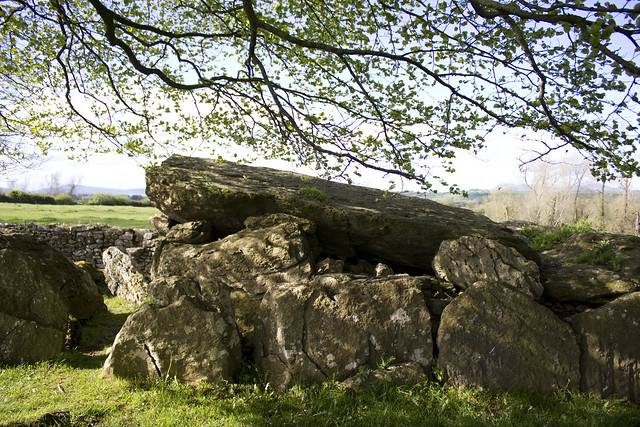Labbacallee Megalithic Tomb Traditional Cache
Labbacallee Megalithic Tomb
-
Difficulty:
-

-
Terrain:
-

Size:  (micro)
(micro)
Please note Use of geocaching.com services is subject to the terms and conditions
in our disclaimer.
 >
>
Labbacallee Megalithic Tomb
The wedge tomb at Labbacallee is the largest of all the Irish wedge tombs, known as the Hag's Bed the tomb is associated with the Celtic Hag -Goddess 'Caillech Bhearra'. The gallery is covered by three massive capstones, the largest weights around ten tonnes and the tomb has three large buttress stones at the rear set parrallel to the gallery. The tomb is also triple walled with large stones .
The front of the tomb is also very impressive it has the remains of a large portico wider than the actual gallery. Around the southern side of the tomb is the remains of the kerbing of the cairn that once covered this huge megalithic monument. Just to the south is a small round cairn, you can see the kerbing of the main tomb in the foreground below. Labbacallee is aligned on the setting sun of the equinox, 22nd March and 24th September when the day is of equal length. On these days the sun illuminates the chamber.
The tomb was excavated in 1934 by H.G. Leask & L. Price and the contents of the main chamber included a 0.60m deep fill of earth and stones with animal bones, fragments of the un-burnt bones of a young male adult and a child, as well as the skull of a female. Fragments of one well-made pottery vessel with incised decoration and some of coarser, flat bottomed pottery were also recovered. In the earth and stones which filled the small end chamber lay the un-burnt remains of a headless skeleton. These un-burnt bones were those of an adult female and it seemed that the body had been partly decomposed when buried. A skewer-like bone pin was found with the bones and it was suggested that the skull from the large chamber belonged to this skeleton. Fragments of coarse pottery and a perforated piece of animal bone were also found along with cremated human bone. Some 50 years after the excavation, three radiocarbon dates of samples of un-burnt bone have produced dates for these burials. The two skeletons in the main chamber were dated to 2,458 - 2,038 BC and 2,202 - 1,776 BC respectively while a long bone from the headless skeleton in the end chamber provided a date of 2,456 - 2,138 BC. These dates would indicate primary burials in the second half of the third millennium BC at intervals over two and a half centuries or so.
There is legend about origin of the name (Hag’s Bed) : "On yonder hill there lived, in days gone by, a giant and a giantess. They were called Shara and Sheela. One day Shara returned from his labours (wood-cutting) in the forest, and finding no dinner ready he was exceeding angry, and in his passion gave Sheela a severe wound with his axe on the shoulder. His passion was assuaged as soon as he saw the blood of his wife, and he carefully bound up the wound and nursed her for many weeks with great care.
Sheela did not, however, forgive Shara for the injury he had inflicted on her. She brooded on her wrong. Eventually she was so far recovered that Shara was able to leave her; and their stock of wood having fallen short, he proceeded to the forest for a fresh supply. Sheela watched her husband as he descended the hill, and, full of wrath, she seized her bed, and, as he was wading through the river, she flung it after him with a dreadful imprecation. The devil changed the bed into stone in its passage through the air. It fell on the giant, crushed him, and to this day he rests beneath the Hag's Bed.
In the solitude which she had made she repented her crime, but she never forgave herself the sin. She sat on the hill-top, the melancholy monument of desolation, bewailing her husband's loss, and the country around echoed with her lamentations. "Bad as Shara was, it is worse to be without him !" was her constant cry. Eventually she died of excess of grief her last words being, "Bad as Shara was, it is worse to be without him !"
The cache
This micro is located next to the megalithic tomb and should be easy find. Remember that Labbacallee is national monument and be careful while searching for cache!
How to get there:
located about 2 kilometres SE of Glanworth, From Glanworth head south on the R512 and take the first left after the church, the tomb is 2 kilometres down this road on your left hand side behind a small wall (sign posted). Parking available next to the monument (at the side of the road)
Information sources: 1)www.themodernantiquarian.com 2)magalithic monuments Ireland on Facebook 
Additional Hints
(Decrypt)
Jbhyq yvxr gb xabj zber!